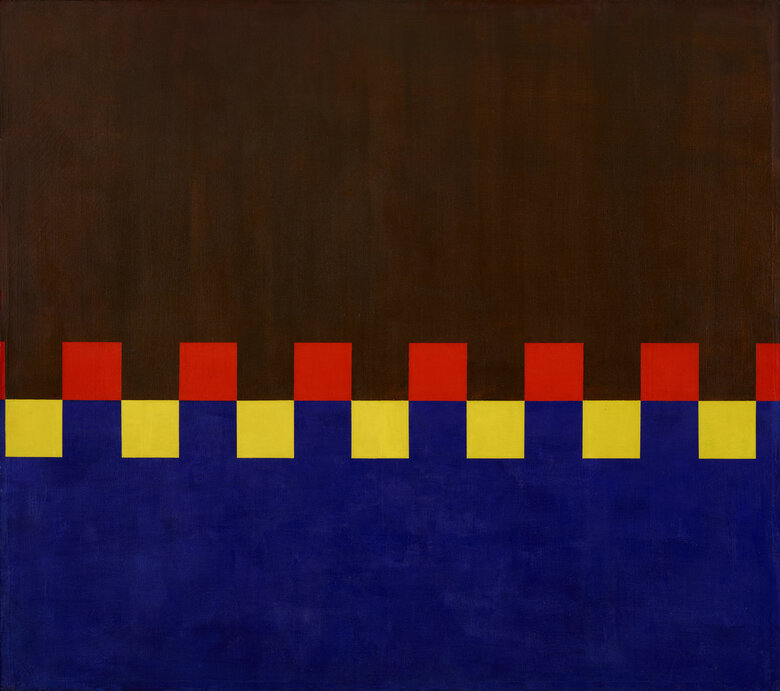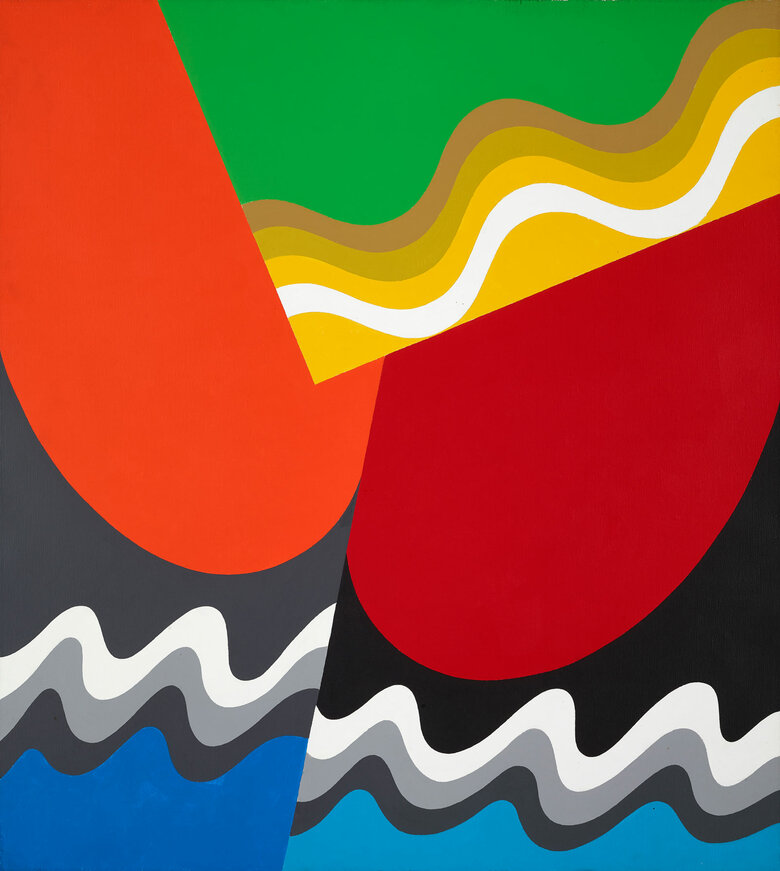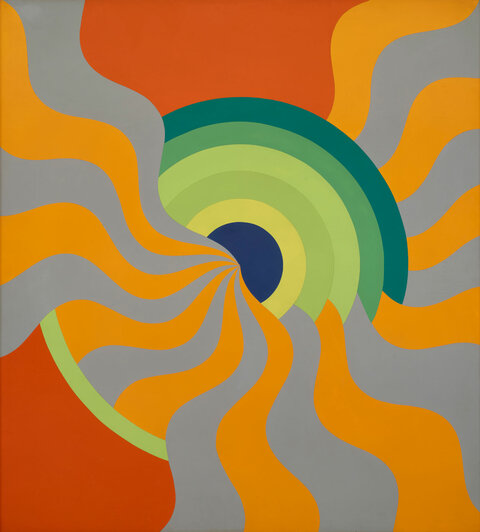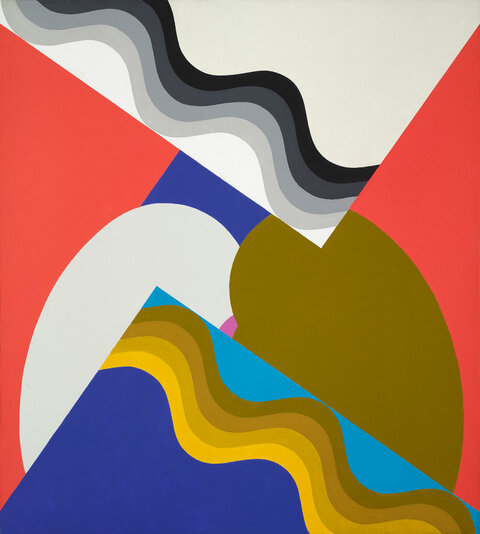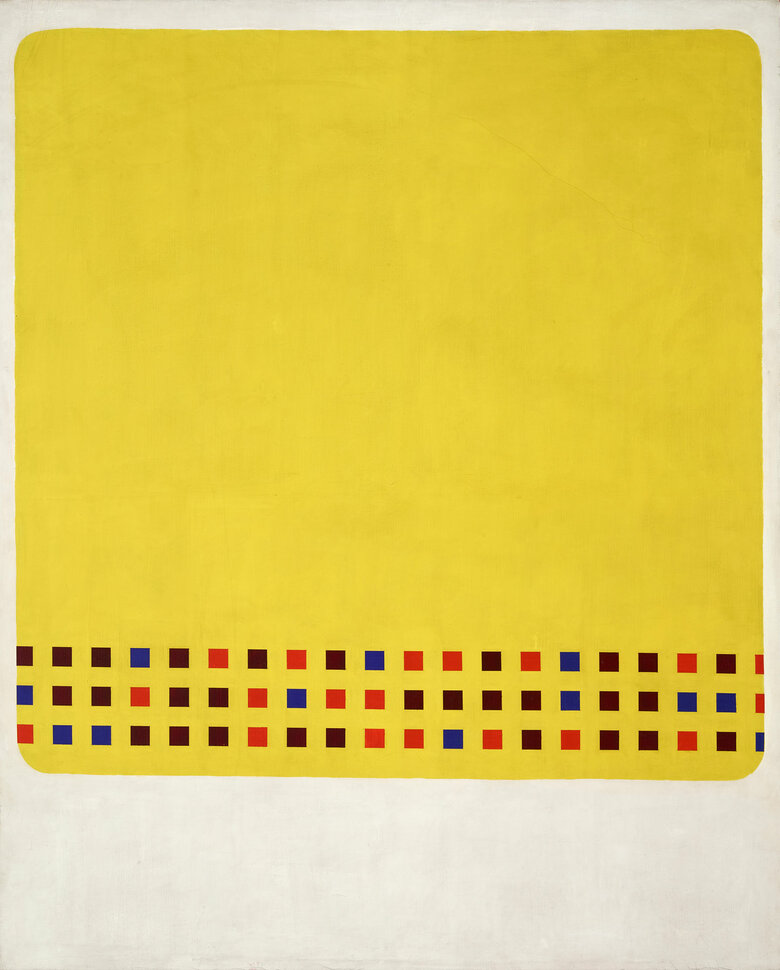Untitled, 1961, a horizontal rectangular painting, is one of Mohamad Melehi’s seminal examples of minimalist hard-edge abstractions, yet one of his rare dim and dark color palettes. Mohamad Melehi was a modernist Moroccan artist and a member of the progressive ‘Casablanca School of Art.'[i]. Melehi was best known for his colorful, vibrant hard-edged abstractions depicting wavy and geometrical flat shapes, mostly executed with acrylic on canvas or industrial cellulose paint on board. However, Melehi executed Untitled 1961with oil on canvas in a dominating coal-black palette.
Untitled, 1961, depicts two hard-edged vertical strips that cross the canvas at its center-left, dividing its flat black background in two. One strip is thin and painted in a phthalo blue, and the other, wider, painted in warm gray. The two trespassing elongated strips barely intersect, nearing the painting’s upper horizontal edge.
While the thin blue strip is slightly tilted to the left at the top and bottom of the painting, the wide one eschews to the right at the painting’s lower bottom part. The bare intersection and hesitantly induced curvature of the two lines create a sense of tension conflicting between connectivity and separation. Sharply cutting through the painting's stark black backdrop, the lines capture the viewer's eyes as they emanate luminosity.
Melehi employs wide, soft, vertical strokes of paint in the backdrop. The background is conducive to highlighting the vertical bands, as it absorbs the light and creates a dark density. The gray paint expands across the canvas, peeking underneath the black edges.
Dominating the left and right sides of the horizontal canvas, the smoothly applied black paint in wide vertical brush strokes appears to be translucent. As the dark tones of black faintly lighten with proximity towards the center, the foreground culminates in the gray and blue lines.
A year before executing this work, Melehi had moved to Paris. He arrived in France in 1960 to practice engraving at the École National Supérieure des Beaux-Artsin Paris. But, Melehi couldn't finish his school year; he felt uncomfortable in an environment imbued with tension due to the French-Algerian conflict back then. So, Melehi decided to go back to Morocco. However, he left for the United States instead in 1962.
During the 1960s, Melehi experimented with the color black. His choice to incorporate black as an authoritative formal element in his work reflects his exploration of cultural heritage, nationalist ideologies, and the socio-political climate of the time. Besides the French-Algerian conflict, the 1960s in Morocco, ruled by King Hassan II (from1960s-1980s), were marked by state violence and repression against political dissidents and democracy activists. The artist’s incorporation of black symbolizes resistance, strength, and the fight against oppression; it serves as a visual representation of the struggles faced by the Moroccan people and an homage to their traditional djellaba[ii].
Moreover, Melehi’s Western training appears through his use of a limited color palette and minimalist abstractions. The juxtaposition of the elongated strips or bands over the use of gray and black reflect his desire to extract light, particularly where it was not very apparent. By emphasizing the nature of the black color, which absorbs light, and contrasting it with lighter shades that reflect luminosity, Melehi skillfully manipulates light in his work. This is achieved through his deliberate brushwork techniques and color choices.
Mohamed Melehi’s Untitled, 1961, showcases his adept exploration of light manipulation. His use of a dark bold color and contrasting slithering lines demonstrates the artwork’s captivating nature. It captures the viewer‘s attention to peer into it. By employing these techniques, Melehi creates a visually imposing piece that reflects his artistic vision and the complexities of cultural identity.
signed and dated on reverse Paris 61
Sources:
hyperallergic.com
identity.ae
www.loftartgallery.net
www.guggenheim.org
dafbeirut.org
www.christies.com
Notes:

-Front.jpg)
-Front.jpg)
